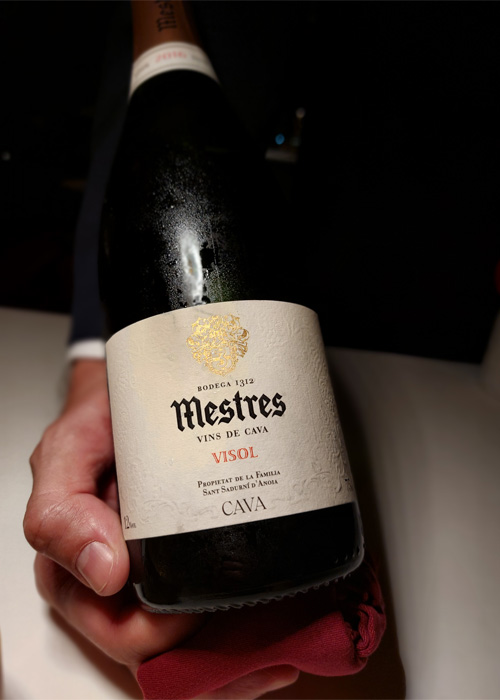Sparkling wine sales are relatively white hot when compared to other styles in these murky, dour days of wine. So yeah, you’d think that Cava would be on everyone’s lips, literally. It’s a cheery and classy value pour as well as — in its more elevated renditions — a celebrated and underpriced paragon of Spanish gastronomy and culture.
For a while there, anecdotally, it seemed like Cava was finally going to be the next big thing and triumphantly overtake its arguably “lesser” competitors at the price point. It fizzed into glasses at parties as a welcome beverage — or after the attendees were sufficiently sloshed to move past the Champagne. It was hailed as the best of both worlds: traditional method, but without the cringe-inducing price tag.
Cava would be coronated at last, and libationary justice would be served. Or so we thought.
So what happened?
It feels like Cava got shoved back into a lonely and infrequently summoned corner of our collective minds — its worthy visage now sporting cobwebs; still waiting for a Johnny Castle to come to the rescue. The marketing message of Cava’s once-powerful brand seems to have lost the plot. Competitors are dominating on social media and leaving the Spanish sparkler to wonder how it let slip the social spell over the bubbly-swilling brunch masses and black-tie revelers it once fleetingly grasped.
In fairness, the Cava category is doing rather well on paper — riding the frothy collective wave along with the rest of its shimmering cohort. And good for them. Sometimes a coattail is just what the doctor ordered.
But, well, does anyone really think about Cava that much anymore? And if not, then why?
A Tale of Two Cavas. Or Three. Wait… Four?
Over the past decade, the Cava D.O. has essentially been going through a progressively more complex economic and philosophical civil war. The smaller producers have been defiantly pushing back against Freixenet and Codorníu — the two behemoths comprising the vast majority of Cava D.O. production volume, and consequently, wielding a dominant share of political influence.
The main casualty of said skirmish? The united name of a global Cava campaign. To make matters worse, this rebellion has splintered into multiple competing factions that have broken off not even all at once, but one after another toward their own specifically noble ideal — with each banner formulating its own set of lofty rules and regulations.
“Many of the top-quality producers have left Cava for Clàssic Penedès and Corpinnat.”
In 2012, the first major salvo of the melee was fired by a single, historical — and deliciously culty — producer, Raventós i Blanc, when it established an exclusive proprietary designation for its terroir and labels, Conca del Riu Anoia. It was a major departure, but nothing the still-unified muscle of the collective Cava nation couldn’t handle.
Then came the Clàssic Penedès D.O. compromise in 2014, an official proposition to regional regulators establishing a prestige sparkling subregion demarcated solely within the confines of the Catalan enclave. (Cava, surprisingly, can officially be sourced from many regions across the entirety of Spain.) By proclaiming a D.O. that actually conveys a sense of terroir and regional pride, this defiant cadre of 15 vintners proudly built its own fortress outside the laws — and naming rights — of Cava.
It’s now been five years since the latest defection hit the shelves. The Corpinnat monkier — a proprietary trade group name not officially recognized within the Cava D.O. or Clàssic Penedès designation — sought to quarantine its 11 meticulously artisanal members from association with the bottomless oceans of basic, if crushable, fizz pumped out by the “Big Cava” corporate interests.
Such a squirrely fragmentation has muddied and diluted the image and brand recognition of Spanish bubbly for global consumers. “I can understand why many of the top-quality producers have left Cava for Clàssic Penedès and Corpinnat,” says Sean Norton, founder of U.S. importer ¿Por qué no? Selections. But he points out that, despite Corpinnat’s translation to “Heart of Penedès” evoking romantically noble intent, the name… well, let’s just say that it doesn’t exactly sing to the non-native speaker.
“The wines are fantastic, but the name is horrible,” Norton says. “I don’t understand why the ‘artisan’ producers would take a name that evokes visions of ‘corporate’ wine.” Likewise, the names Clàssic Penedès and Conca del Riu Anoia, while being less evocative of exactly what they’re not, are equally cumbersome and unrecognizable when compared to an undeniably sexy utterance like “Cava.” Admit it, you just said it yourself and loved it.
“Honestly, it’s impossible to compete with the Italian marketing wizards. Cava at €6 to €7 per bottle is the wrong way.”
Despite representing high-quality artisanal loyalists still labeled with the Cava name like Jaume Giró i Giró, Norton regrets the acrimonious fragmentation and state of the brand. “I think the Cava D.O. missed an opportunity to promote their top-quality wines and producers,” he says. “In my opinion, these top wines consistently outperform … [but] don’t get the recognition they deserve. My fear is that it may be too late given the exodus.”
By Defining Its Enemy, Cava Defines Itself
The Cava name has been forced by its dominant “Big Cava” interests into a race to the bottom.
Prosecco has captured lightning in a bottle with the casual cocktail scene. Sure, while many “cool kids” have long since decided that the Aperol Spritz is so passé, the typically Prosecco-based drink continues to absolutely dominate summertime scenes globally. It doesn’t seem to matter that tastemakers have moved on to find the next big under-the-radar cultural concoction — the bouncy sunshine sipper continues to laugh all the way to the bank.
And Cava, yes, its value bottlings are a fabulous mixology base and accent — arguably far better than Prosecco. But what comes to mind when trying to recall a signature Cava cocktail off the top of your head?
Probably nothing, right? And that’s a problem.
When it comes to chasing down the Prosecco supercar, Joan Jofra thinks it’s a lost cause. “Honestly, it’s impossible to compete with the Italian marketing wizards,” he says. As the owner of Agüita Wine Club & Cellar, a locavore wine/tapas bar and retailer in the heart of Barcelona’s old town, he has witnessed firsthand the frantic pursuit. “Cava at €6 to €7 per bottle is the wrong way,” he adds.
“Cava shouldn’t compete with Prosecco. It’s another production method, [and] we think that Cava should be a Barcelona/Catalunya brand.”
Jofra cautions that truly iconic small wineries still carrying the Cava D.O. flag, like Mestres, are getting dragged down in the reckless dash. “I think it’s a mistake to have their product seen as similar to the big names,” he warns. It’s a bit like assuming Jacques Selosse is just another quaffable French Crémant. “Big Cava” has been chasing Prosecco off a cliff — with several artisanal producers still helplessly attached.
The Great Cava Reunification Bid
For the wineries that have deserted the instantly identifiable Cava stamp and retreated into their own distinct breakaway kingdoms — whether under Clàssic Penedès, Corpinnat, or the monopole-ish Conca del Riu Anoia — the idea of reunification with their former supervisor likely sounds about as wise as another attempt at the “Roseanne” reboot.
But to its credit, the Cava D.O. has recently enacted updates to its governing rules to shine up its tarnished image and, just maybe, lure back some of its disgruntled turncoats.
The regulatory body created fresh subregion and quality designations, and announced the intent for all Cava labeled “Cava de Guarda Superior” to be 100 percent certified organic farming by 2025. While the D.O.’s spiffy new threads are most certainly a welcome change — especially for those remaining artisanal members still faithful to the Cava name — many doubt that it will repair the fissures that have cleaved the Cava family into their own camps.
“There’s a lot to unwind and certainly plenty of ego, politics, and control issues to sort through.”
And even with the gussied up labeling options now available, the general Cava D.O. continues to incorporate regions from all around Spain, and the mega-producers are still sprinting in a desperate attempt to match Prosecco’s fleet stride.

“Cava shouldn’t compete with Prosecco,” says Ramon Jané Garriga, owner of distinguished Corpinnat producer Celler Mas Candí. “It’s another production method, [and] we think that Cava should be a Barcelona/Catalunya brand. The work I’m doing with Corpinnat is to improve the Penedès.” The approach that large producers are taking is antithetical — not to mention detrimental — to those who have left the D.O. The whole point was to differentiate themselves both regionally and qualitatively. “In Corpinnat, we have to get a share of the Champagne consumer,” Garriga concludes. “Our competition must be Franciacorta and Champagne.”
From the U.S. importer perspective, Norton is skeptical of the possibility of reconciliation. “There’s a lot to unwind and certainly plenty of ego, politics, and control issues to sort through,” he says. As for Jofra from his Barcelona storefront, he believes it’s most likely a futile endeavor. “Nobody knows what the politics may decide. But I don’t see it.”
However, the ultimate conclusion of this effervescent telenovela almost certainly remains unwritten. As the new plot elements settle into the scene, the estranged family members involved are initiating fresh character arcs — and recently established loyalties and alliances may be tested.
For better or for worse, we might very well be in for another round of Cava-drama fizzing up in northeastern Spain in the near future. We’ll see whether or not the brand can recapture the attention and adoration of its audience.
This story is a part of VP Pro, our free platform and newsletter for drinks industry professionals, covering wine, beer, liquor, and beyond. Sign up for VP Pro now!
